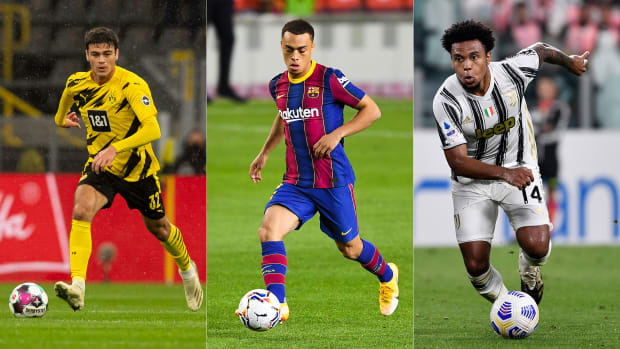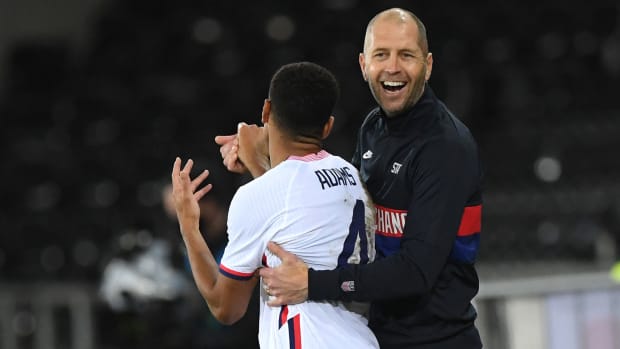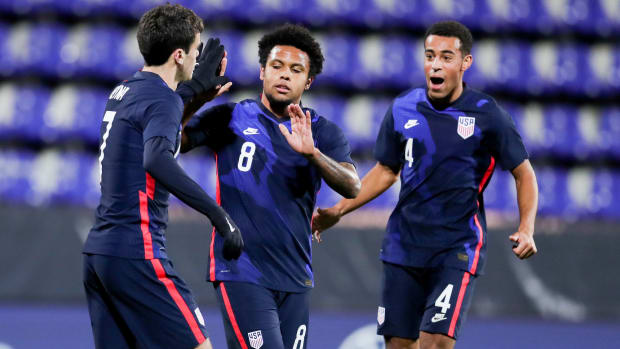To think about breaking the U.S. men's national team's glass ceiling, though, you must first understand how high it stands.
There have been, by U.S. soccer’s historically modest standards, a couple close calls. In 2002, a men’s national team that probably was the best the country ever fielded outplayed Germany in a World Cup quarterfinal and was denied extra time by an unsympathetic referee. Eight years later in South Africa, the USA won its group and faced the most forgiving path to the semis it was ever going to get: Ghana and Uruguay. But the Americans fell to the Black Stars in the round of 16.
That’s as close as the USA has come to contending at a modern World Cup. Now, consider how much further it has to go.
Here’s a statistic to ponder. Let it provide some context for all the conversation, hype and footballing fantasies now taking root. Since the World Cup expanded to 32 teams in 1998, the eventual tournament champion has won an average of six matches. That’s six victories in one month. The U.S. men’s national team has won six World Cup games combined in the past 70 years. That’s six victories across 18 tournaments.
Granted, five have come in the past eight World Cups. So that’s a relative hot streak. But still, the broad trends that somehow seem to govern World Cups suggest the USA isn’t close to contending. Its single knockout-stage win was 18 years ago against familiar foe Mexico, and since each subsequent round is logarithmically more difficult—barring a historic fluke—it’s pretty clear that at this point, the USA is a lot more likely to miss a World Cup altogether than challenge for the crown. And that fact was hammered home three years ago.
In 1989, the U.S. program made its first big leap, qualifying for a World Cup for the first time in 40 years. It became a participant. To become a contender, it must make another big leap. For a couple decades now, the USA has been running in place. Group stage exits. Round-of-16 exits. Couva. A leap to the World Cup quarterfinals and beyond requires a historic disruption of that inertia. But there’s evidence that disruption is finally happening. Within the past year or so, young U.S. players are suddenly being signed by the sport’s biggest clubs. Christian Pulisic is at Chelsea. Weston McKennie is at Juventus. Tyler Adams is at RB Leipzig, a Champions League semifinalist. There are now two Americans at Barcelona, and more coming up at Bayern Munich, Borussia Dortmund, PSV Eindhoven and more. This feels different. It is different.

And so this new U.S. national team, the one that may redefine what’s possible for American soccer, took its first step into that new era over the past week. After a 10-month pandemic pause (or longer for many), during which the player pool evolved significantly, coach Gregg Berhalter gathered his squad of emerging stars for friendlies against Wales (a 0-0 draw) and Panama (a 6-2 win).
For the coaches and players, it was a chance to spend time with each other, establish a bit of chemistry and start drilling down on Berhalter’s principles of play. The 24-man team initially included 10 uncapped players and 19 eligible for next summer’s U-23 Olympic qualifiers and finals. There was a lot of work to do, and not a ton of time. But during Zoom calls with the media, there were just as many questions about hype, potential and promise as there were about Wales and Panama. That’s what people want to read about. It’s what fans, still sore after the Couva catastrophe, want to revel in. The weight of hope and expectation now hangs over a U.S. team like never before, and Berhalter and his players found they’d have to manage that as much as they’d have to deal not only with the training sessions and games in front of them, but in simply getting to know each other.
This game-changing team is still just finding its feet.
“The hype in general comes from the outside—from the media, from the fans—and I think we’re not really playing for the expectations of other people. We’re playing for the expectations within our group, within our team, within our brotherhood that we have here,” McKennie said.
“We have expectations. We have desires. And I think the most important thing is just to keep [all the young players] working, including myself,” the Juve midfielder continued. “It starts with us, and we have to kind of show that and let them know, ‘Hey, you haven’t made it yet. Day in and day out you have to bust your balls to play. You gotta bust your balls and you’re representing a whole country.’”
Said defender Reggie Cannon, an FC Dallas product who lauded the level of competition he’s now getting at Portugal’s Boavista, “One thing I can say to the national team fans is be patient. … We have a lot of talented individuals obviously, and what’s going to make this team great is if we play for each other. And that’s something we’re figuring out.”
Berhalter also endeavored to establish a reasonable benchmark. Unlike recent USMNT predecessors, he’s committed to the painstaking work of establishing both a coherent and consistent style of play, and an inclusive, uplifting team culture. Neither is easy, especially with so much new blood. The past week was a reminder of how much goes into laying those foundations.
“One thing I’ve noticed especially when you’re working with new players or a group that’s just forming is, you go through different stages of team development,” Berhalter said. “With this group in particular, it is more of individuals looking for their position within the team, and we clearly want to move to more of a team-orientated standpoint as we get into [World Cup] qualifying.
“It’s completely natural what’s happening now,” he added. “A guy wants to come into camp. He wants to make a good impression on the coaching staff. He wants to play really well, and he’s focused more on himself. As he gets more comfortable now, he’s focused more on his teammates. And we certainly want to get into that stage by qualifying because that’s going to be really important.”
Qualifying is the first measuring stick. Before the USA can contend globally, it has to get back to dominating regionally. Next year will provide an ideal opportunity. Following the March friendly window, the USA will enter the four-team Concacaf Nations League finals in June. It’s a minor title, but success would whet the appetite. The Gold Cup starts in July, and then Concacaf’s World Cup qualifying octagonal finally gets underway in September.
Berhalter said Monday that he’s unlikely to call in his contingent of European A-listers for both the Nations League and Gold Cup, meaning it’s one or the other, plus the March window, for those players between now and next September. Again, that’s not a lot of time.
But the USA doesn’t have to win a World Cup next fall. It just has to beat the likes of Costa Rica and Honduras. And while Monday's defensively-deficient Panamanian side may not have been the best litmus test, there clearly was progress made over the past week-plus, both from a coaching perspective and among the players. Berhalter saw some things and probably learned some things, while his charges appeared to be positive about being in camp and about playing with each other. Those are foundational building blocks.

We saw Adams play as the lone defensive midfielder in Berhalter's three-man midfield for the first and second time, quickly establishing himself as the guy who probably should man that role for the next decade. And we saw McKennie and dual-national Yunus Musah connect, cover ground and drive the ball forward in occasionally dominant fashion. If that dynamic was enough to convince Musah to commit his international future to the USA, then the camp will have been a smashing success.
But there was more. The USA defended and pressed well out of that 4-3-3 against Wales. In that match, despite the offensive stagnation, the young Americans never lost their defensive focus. And against Panama, despite going down early and then losing its grip on the game early in the second half, the U.S. recovered and put Panama in its place. Berhalter got a look at his team attacking with a false nine and with a more traditional striker, and saw how debutant Gio Reyna found (or didn’t find) space to contribute behind each. Depth at striker was a concern, with the absent Josh Sargent still unproven and Jozy Altidore aging. But Nicholas Gioacchini and Sebastian Soto—each 20 years old and with the senior squad for the first time—demonstrated some comfort in the penalty area and contributed two goals apiece. Further back, Berhalter had the opportunity to field Sergiño Dest at both right and left back, while testing a couple different center back pairings and getting Zack Steffen valuable minutes in net.
There was plenty to digest. And that constitutes a good start on a long journey.
“You can still see a lot of times we’ve only been together for a week. I think you also saw some really good things,” said Reyna, who turned 18 last Friday and scored his first U.S. goal on Monday. “Everybody’s been getting along very well off the field too. So I think on and off the field it’s just slowly bringing this group together where by the time qualifying comes, we’ll be ready to compete and [have] very good chemistry on and off the field.”
That chemistry isn’t a given, considering they all come from different clubs in different leagues. Fans can swoon over the teams these men play for, but that doesn’t guarantee cohesion when they come together. Plenty of countries head to a World Cup with impressive rosters and then leave early because chemistry and humility are absent. The young Americans, however, carry a burden in common. Many are pioneers, in a sense—one of the first, if not the first, from their country to be counted on at their respective club. Rather than fuel a sense of ego or entitlement, it seems to have left them appreciating, supporting and challenging each other.
“The best thing for us to do is to go to Europe and challenge yourself and get a taste of what real football is like, because I think that’s ultimately going to create so much challenge and so much unity within the team that everyone can experience this lifestyle and challenge each other for spots,” Cannon said. “I think that’s what makes teams great.”
The chemistry is evident in interviews and on Instagram, and on the field as well. At times, this U.S. team was genuinely fun to watch. There was panache and confidence on the ball—the sort of flicks, quick touches and dexterity that Landon Donovan and Clint Dempsey used to show on their own, but that now several of these players can perform in combination—as well as the fluid, 360-degree awareness not too frequently seen among American men.

“We all know that we like to play. We like to combine. We like to make those small touches and small passes, and I think whenever you get into that type of confidence that you can play with your guys and everything, then I think it just brings out the confidence in yourself,” McKennie said. “I think a lot of the guys felt the comfortability with the other players on the field and we enjoyed it, We had fun. … It’s a good stepping stone and I think it was a good start after not being together for a whole year.”
The possibilities are intriguing. But one barrier must fall at a time. A team with good young players who enjoy working together is a start, but there’s so much further to go. While this U.S. squad has a few individuals scattered across some big clubs, the national teams it's chasing–the elite–have dozens. They have depth that would tie Berhalter in knots. Here’s another stat to consider, courtesy of Transfermarkt: While the USA currently has three players valued at more than $20 million (Pulisic, McKennie and Dest), world champion France has 25 players valued that highly who have never even been called in to the senior national team. It’s night and day. There is such a long way to go.
But you can’t get there without coming this far first. This improvisational camp, featuring two closed-door games and so many new faces, went as well as can be expected. And so a journey of 1,000 miles begins with a single stepover.